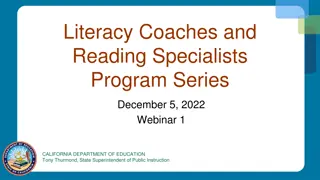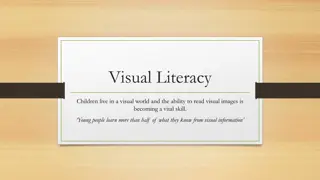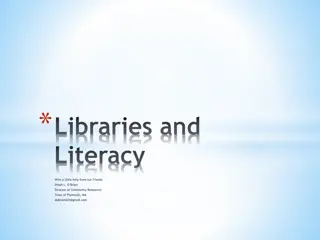Maximizing Literacy Achievement: Effective Instruction Planning Strategies
Timothy Shanahan from the University of Illinois at Chicago discusses key considerations for planning effective literacy instruction, including scheduling, amount of instruction, content to be taught, and the timing of instruction. Shanahan emphasizes the importance of providing ample literacy instruction time, focusing on essential literacy components, and maintaining flexibility in scheduling to optimize student learning outcomes.
Download Presentation

Please find below an Image/Link to download the presentation.
The content on the website is provided AS IS for your information and personal use only. It may not be sold, licensed, or shared on other websites without obtaining consent from the author. Download presentation by click this link. If you encounter any issues during the download, it is possible that the publisher has removed the file from their server.
E N D
Presentation Transcript
How to Plan Effective Literacy Instruction TIMOTHY SHANAHAN UNIVERSITY OF ILLINOIS AT CHICAGO WWW.SHANAHANONLITERACY.COM
Purposes I have been critical of several scheduling schemes (e.g., Reading Block, Daily 5, Caf , Readers/Writers Workshop) These schemes see aim to provide teachers with an easy plan for organizing their daily instruction (if you have to come up with a total different schedule every day you ll go crazy) My goal, on the other hand, is both to schedule reading in a manageable way for teachers, but also in a way that has a chance of maximizing reading achievement
Amount of Instruction The first decision that teachers need to make is how much literacy instruction to provide More literacy instruction can increase literacy achievement, so I try to increase the amount of reading instruction provided The average amount of literacy instruction offered is about 90 minutes per day Therefore, I try to provide more than 90 minutes daily Not all situations are equal, so I require between 120-180 minutes per day (more than that will impinge on content teaching)
What Needs to be Taught Research has found that teaching phonemic awareness, letters, decoding, high frequency words, oral reading fluency, reading comprehension (strategies and written language), and writing improve literacy achievement Need to accommodate all of those I require teaching of word knowledge (including both decoding and word meaning), fluency, comprehension, and writing Accord equal amounts of time to each of those four components
Morning or Afternoon Everyone knows that kids learn best in the morning, so literacy instruction has to be scheduled then Except research doesn t support what everyone knows There is no difference between amount of learning that is accomplished in the AM & PM Being able to use both the morning and afternoon allows for greater amounts of literacy instruction and greater flexibility (particularly with pullout programming)
To Block or Not to Block Many districts are committed to the uninterrupted reading block (9-10:30 we teach reading) But research supports no particular scheduling plan Reading blocks tend to lower the amount of reading instruction that can be given (does instruction really begin at 8 or 9AM) They also reduce the flexibility of pullout programs which often means kids get replacement teaching rather than in addition to instruction
Planning by Purpose, Not Activity Schemes like Daily 5 encourage teachers to schedule on the basis of particular activities read to self, read to someone, listen to reading, word work, writing Research shows that teachers (and other professionals) have difficulty staying focused on what they are trying to accomplish rather than on activities These activity oriented schemes focus teachers on activities rather than outcomes BIG MISTAKE!
Planning by Purpose, Not Activity (cont.) There is more than one way to teach something don t lock yourself into particular activities, especially those that don t have a consistent record of effectiveness at teaching some essential component of reading Don t organize around activity, but around purpose I m trying to teach kids to understand words how to decode them and their meanings; to read text fluently; to teach students to read with comprehension; to write effectively (organize your day around goals and then select activities aimed at accomplishing those goals)
Planning by Purpose, Not Activity (cont.) One of the benefits of organizing by purpose is that it tips teachers off as to the kinds of time commitments that needed to accomplish particular goals Experts: Most authorities recommend 20-45 minutes per day of phonics instruction in primary grades (many teachers do the decoding pages in their core programs much more quickly a problem in terms of guiding kids to be good decoders)
Whole Class, Small Group Small group instruction is more effective than whole class instruction However, that isn t the choice for teachers/schools When small group instruction plus the necessary seatwork that facilitates it are compared to whole class instruction it s a wash Seatwork, independent reading time, computer time, etc. are not as effective as working with a teacher Many schools insist on small group instruction time but that is a big mistake Use small group instruction when necessary, but minimize this when possible
Whole Class, Small Group (cont.) Try to make whole class instruction as effective as possible Seating arrangements, turn taking and response routines, teacher movement are all tools that can reduce the need for small group teaching Consider using small group for reteaching rather than teaching Instead of thinking of 2 hours of instruction overall, think of 2 hours of instruction for each child (thus, with 3 small groups, each group would receive only about 40 minutes of instruction)
In-Class Intervention One way to expand beyond the 2-hour plan is to schedule additional time for in-class intervention For this, there isn t a different teacher, a different classroom, or a different curriculum This time (usually requiring small groups) is devoted to reteaching lessons when kids aren t succeeding or for catching certain kids up with what they were missing previously
Motivating Reading Many teachers devote substantial amounts of time to activities that supposedly increase student motivation to read (e.g., reading to kids, independent reading time) However, neither of these activities has been found to either improve reading achievement or reading motivation with school- age students That doesn t necessarily mean banning these activities, but it should not be counted as instructional time in most instances
Content knowledge Reading comprehension depends upon background knowledge The more knowledge that students have the better their chances of comprehending well Schools should not minimize science, history, or the arts for literacy instruction Pull-out interventions often must remove students from content classes, but efforts should be made to minimize the effects of this (e.g., content texts in reading, parent involvement)
Language Reading is a language activity--students who are low in language development often struggle with reading, too Studies show that instruction can improve oral language proficiency, but no studies yet show that such improvement translates to higher reading achievement An exception to this is with English Language Learners (dedicated time on oral English does make sense with these children) However, studies do show that instruction of written language (vocabulary, grammar, cohesion, text structure) do have positive impacts on reading comprehension (that should be part of reading comprehension instruction Otherwise, teachers should use model English, should correct student language errors, encourage interaction within instruction
A second-grade schedule (cont.) Reading comprehension is given more time here than the other components, but that is because the teacher is working with two groups and it will take 45 minutes to deliver 30 mins of instruction with each group Oral reading fluency is paired reading and it has been divided into two time periods Math is here because the math supervisor hasn t read the research and she is sure that kids learn math better in the morning (I m willing to accommodate her) Word knowledge (the focus here is on decoding/phonics)
A second-grade schedule 8:10-9:00 9:00-9:15 10:15-10:45 10:45-11:15 10:45-11:15 11:15-12:15 12:15-12:30 12:30-3:30 Reading comprehension instruction Oral reading fluency Math Word knowledge Writing Lunch/recess Oral reading fluency (social studies, science, music, art, PE, library/computer
A fourth-grade schedule 8:10-9:10 9:10-9:40 9:40-10:20 10:20-11:50 11:50-12:50 12:50-3:30 Reading comprehension instruction Oral reading fluency Music Word knowledge Lunch/recess (math social studies, science, art, PE, library/computer)
A fourth-grade schedule Reading comprehension will be taught whole class in this instance, and writing is not included at all (they are alternating these to allow for more extensive coverage)























